
Brussels, officially the Brussels-Capital Region, is a region of Belgium comprising 19 municipalities, including the City of Brussels, which is the capital of Belgium. The Brussels-Capital Region is located in the central portion of the country and is a part of both the French Community of Belgium and the Flemish Community, but is separate from the Flemish Region (Flanders), within which it forms an enclave, and the Walloon Region (Wallonia), located less than 4 kilometres (2.5 mi) to the south.

Anderlecht is one of the 19 municipalities of the Brussels-Capital Region, Belgium. Located in the south-western part of the region, it is bordered by the City of Brussels, Forest, Molenbeek-Saint-Jean, and Saint-Gilles, as well as the Flemish municipalities of Dilbeek and Sint-Pieters-Leeuw. In common with all of Brussels' municipalities, it is legally bilingual (French–Dutch).

Koekelberg is one of the 19 municipalities of the Brussels-Capital Region, Belgium. Located in the north-western part of the region, it is bordered by Berchem-Sainte-Agathe, Ganshoren, Jette, and Molenbeek-Saint-Jean. In common with all of Brussels' municipalities, it is legally bilingual (French–Dutch).

Molenbeek-Saint-Jean or Sint-Jans-Molenbeek, often simply called Molenbeek, is one of the 19 municipalities of the Brussels-Capital Region, Belgium. Located in the western part of the region, it is bordered by the City of Brussels, from which it is separated by the Brussels–Charleroi Canal, as well as by the municipalities of Anderlecht, Berchem-Sainte-Agathe, Dilbeek, Jette, and Koekelberg. The Molenbeek brook, from which it takes its name, flows through the municipality. In common with all of Brussels' municipalities, it is legally bilingual (French–Dutch).

Schaerbeek or Schaarbeek is one of the 19 municipalities of the Brussels-Capital Region, Belgium. Located in the north-eastern part of the region, it is bordered by the City of Brussels, Etterbeek, Evere and Saint-Josse-ten-Noode. In common with all of Brussels' municipalities, it is legally bilingual (French–Dutch).
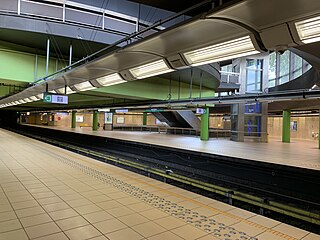
Saint-Guidon or Sint-Guido is a Brussels Metro station on the western branch of line 5. It is located in the municipality of Anderlecht, in the western part of Brussels, Belgium. The station received its name from the aboveground Collegiate Church of St. Peter and St. Guido, itself named after Saint Guy, the patron saint of Anderlecht.

Osseghem or Ossegem is a Brussels Metro station on lines 2 and 6. It is located under the Chaussée de Gand/Gentse Steenweg in the municipality of Molenbeek-Saint-Jean, in the western part of Brussels, Belgium. The station takes its name from the nearby Osseghem/Ossegem neighbourhood.

Beekkant is a Brussels Metro station on lines 1, 2, 5 and 6. It is located under the Boulevard Edmond Machtens/Edmond Machtenslaan in the municipality of Molenbeek-Saint-Jean, in the western part of Brussels, Belgium. The station's name translates into English as "Brookside".
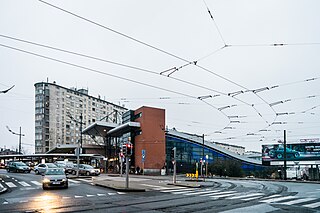
Brussels-West Station is a multimodal transport hub located in the municipality of Molenbeek-Saint-Jean, in the western part of Brussels, Belgium. It mainly consists of Gare de l'Ouest (French) or Weststation (Dutch), a Brussels Metro station on lines 1, 2, 5 and 6, as well as a tram and bus stop. Additionally, Brussels-West railway station is a railway station operated by the National Railway Company of Belgium (SNCB/NMBS). It is served by the Brussels Regional Express Network (RER/GEN) service.

Étangs Noirs or Zwarte Vijvers is a Brussels Metro station on lines 1 and 5. It is located at the border between the municipalities of Koekelberg and Molenbeek-Saint-Jean, in the western part of Brussels, Belgium. The station's name translates into English as "Black Ponds".
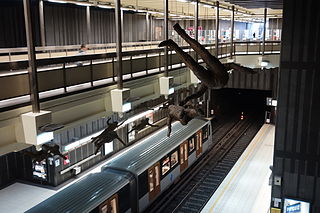
Comte de Flandre or Graaf van Vlaanderen is a Brussels Metro station on lines 1 and 5. It is located in the municipality of Molenbeek-Saint-Jean, in the western part of Brussels, Belgium. The station takes its name from the nearby street Rue du Comte de Flandre/Graaf van Vlaanderenstraat.
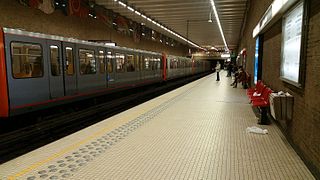
Ribaucourt is a Brussels Metro station on the northern segment of lines 2 and 6. It is located under the Boulevard Léopold II/Leopold II-laan in the municipality of Molenbeek-Saint-Jean, in the western part of Brussels, Belgium. The station takes its name from the Belgian noble family De Ribaucourt, as well as De Ribaucourt park and castle.

The tram route 51 in Brussels, Belgium, is a tram route operated by STIB/MIVB, which connects Heysel/Heizel metro station in the City of Brussels to the Van Haelen stop in the municipality of Uccle. The route runs north–south, crossing the City of Brussels, Jette, Molenbeek-Saint-Jean, the City of Brussels again, Saint-Gilles, Forest and Uccle. Currently, service is interrupted between Brussels-South railway station and Altitude Cent/Hoogte Honderd due to construction work at Albert premetro station.

The tram route 82 in Brussels, Belgium, is a tram route operated by STIB/MIVB, which connects Berchem-Sainte-Agathe railway station in Berchem-Sainte-Agathe to Drogenbos Castle in the Flemish municipality of Drogenbos. After 8 p.m., the route terminates at Brussels-South railway station, with connections to Drogenbos provided by tram route 32.
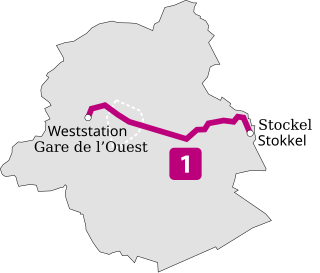
Line 1 is a rapid transit line on the Brussels Metro in Belgium operated by STIB/MIVB. It has existed in its current form since 4 April 2009, when former line 1B, which ran between Stockel/Stokkel and Erasme/Erasmus, was shortened to Gare de l'Ouest/Weststation. The section between Gare de l'Ouest and Erasme is now served by line 5. The line serves 21 metro stations, and has a common section with line 5 between Gare de l'Ouest and Merode, and with lines 2 and 6 between Gare de l'Ouest and Beekkant. At Arts-Loi/Kunst-Wet, the line also connects with lines 2 and 6. Railway connections are possible at Brussels-Central, Brussels-Schuman, Merode and Brussels-West. The line crosses the municipalities of Molenbeek-Saint-Jean, Koekelberg, City of Brussels, Etterbeek, Woluwe-Saint-Pierre and Woluwe-Saint-Lambert.

La Fonderie, Brussels Museum of Industry and Labour is a museum of industrial history in Brussels, Belgium. It collects objects, documents and oral history on the city's industrial past and visualises the working history of Brussels. It is managed as a nonprofit organisation focusing on analysing and exhibiting the economic and social history of the Brussels region. It publishes a magazine, organises guided tours and provides educational activities. La Fonderie also houses a documentation centre open to the public.

The Church of St. Augustine is a Catholic parish church in Forest, a municipality of Brussels, Belgium. It is dedicated to Saint Augustine.

The Church of St. John the Baptist is a Catholic parish church in the centre of Molenbeek-Saint-Jean, a municipality of Brussels, Belgium. It is dedicated to Saint John the Baptist, the patron saint of Molenbeek.

The Municipal Hall of Anderlecht is the municipal hall building and the seat of that municipality of Brussels, Belgium. Designed by the architect Jules Jacques Van Ysendyck in neo-Flemish Renaissance style and completed in 1879, it is located at 1, place du Conseil/Raadsplein in Cureghem/Kuregem. This site is served by Clemenceau metro station on lines 2 and 6 of the Brussels Metro, as well as the tram stop Conseil/Raad.

The Municipal Hall of Saint-Gilles is the municipal hall building and the seat of that municipality of Brussels, Belgium. Designed by the architect Albert Dumont in neo-Flemish Renaissance style and completed in 1904, it is located at 39, place Maurice Van Meenen/Maurice Van Meenenplein. This site is served by the premetro station Horta, as well as the tram stop Lombardie/Lombardije.




















